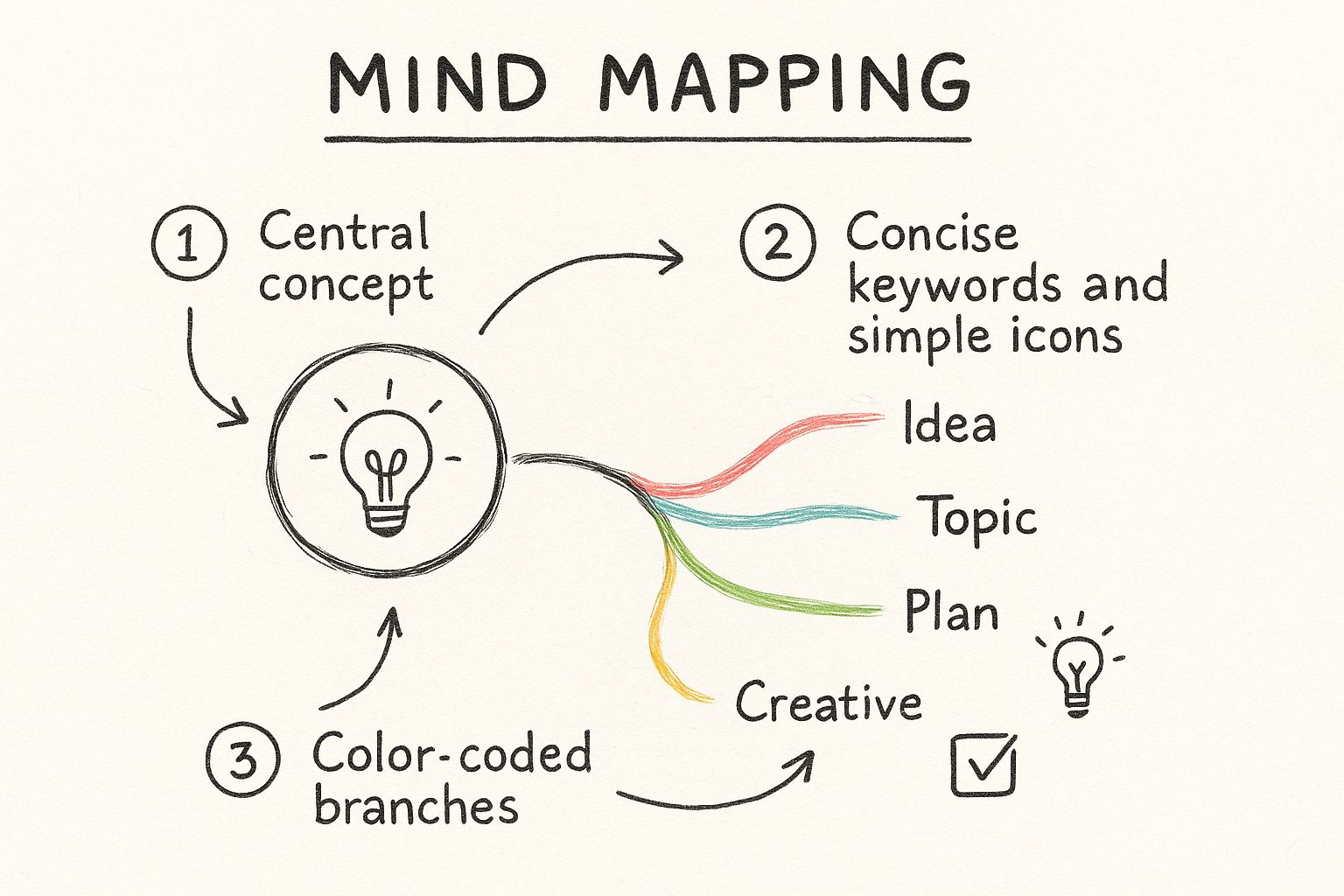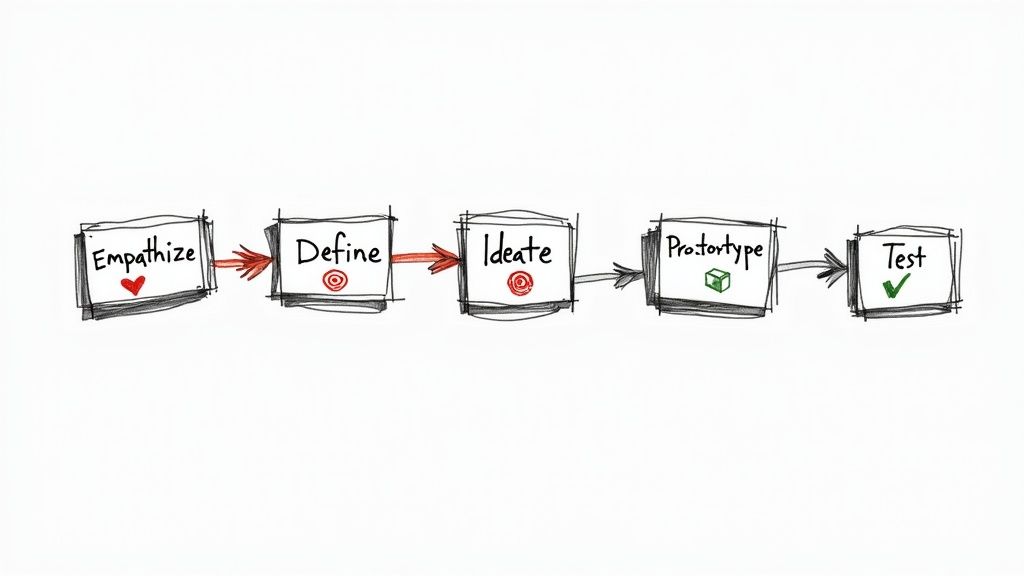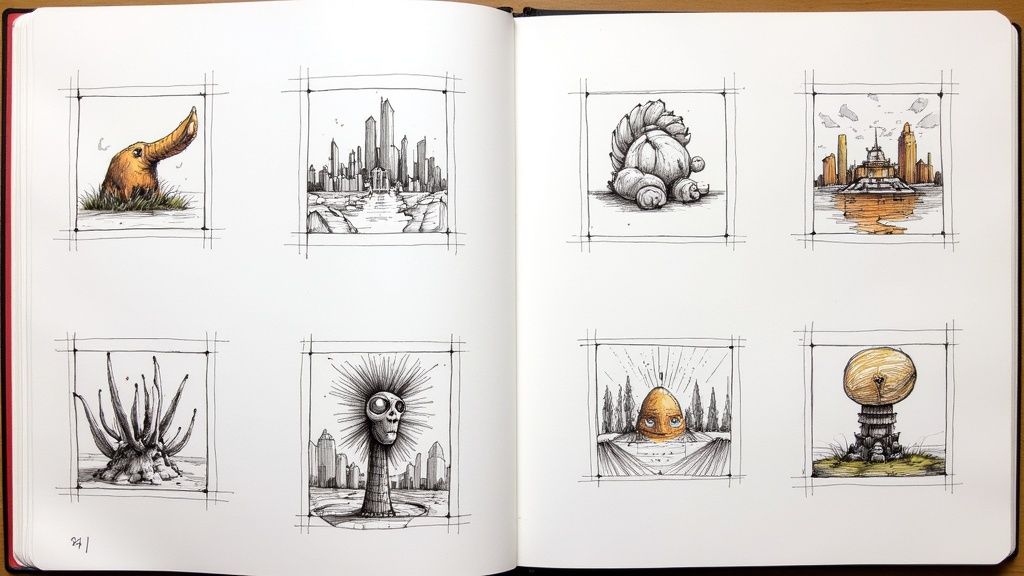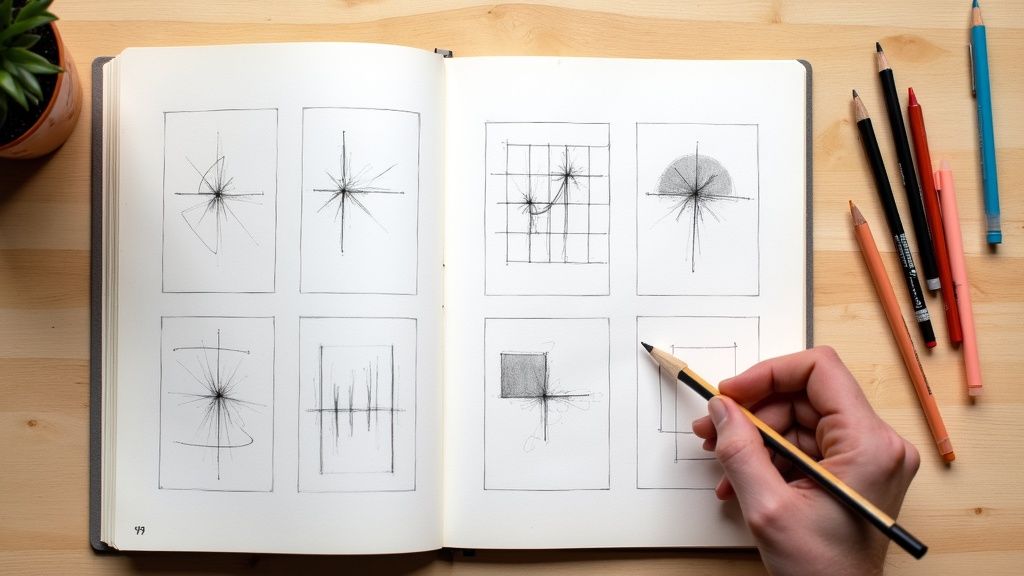Every great creation begins with a simple mark, a preliminary thought, an initial sketch. Yet, staring at a blank page can feel like facing a creative void, a common hurdle for artists and thinkers alike. How do you bridge the gap between an abstract thought and a tangible form? The answer lies in mastering diverse ideas sketch techniques, which are structured methods for visual brainstorming that transform concepts into concrete visuals. This guide moves beyond generic prompts, offering a curated collection of seven distinct sketching methodologies used across various professional fields.
This article explores specific approaches used by architects, designers, scientists, and artists to capture inspiration, solve complex problems, and foster innovation. We will provide a detailed look into each method, ensuring you understand not just what to sketch but how to approach the process for maximum creative output.
Whether you are a professional seeking new ways to ideate or a hobbyist looking to overcome an artistic block, these proven techniques will equip you with a powerful visual toolkit. We will dive into the specific features, practical applications, and actionable tips for each method, including Mind Mapping, Concept Art Sketching, and UI/UX Wireframing. This list provides everything you need to start sketching with purpose and confidence, turning any blank page into a field of potential.
1. Mind Mapping: Charting Your Thoughts Visually
Mind mapping is a powerful visual thinking tool that organizes information hierarchically around a central concept. By using branches, colors, and images to stimulate creative thinking, this technique mirrors the brain's natural associative thought patterns. It is an intuitive way to explore and connect complex ideas, making it a foundational ideas sketch method for any project. Instead of linear note-taking, a mind map allows your thoughts to radiate outwards, creating a dynamic and flexible structure for brainstorming.
This method excels at breaking down complex subjects into manageable parts. For instance, major companies like Apple have used mind mapping for product development planning, while medical students rely on it to visualize and memorize complex anatomical systems. The technique was popularized by author and educational consultant Tony Buzan, who championed it as a more brain-friendly way to learn and innovate.
When to Use This Method
Mind mapping is most effective during the initial stages of a creative project when you need to explore a concept from multiple angles without restriction. It is ideal for:
- Brainstorming new concepts: Quickly generate and connect ideas for a character, story, or product.
- Organizing complex information: Deconstruct a large topic into smaller, interconnected sub-topics.
- Planning projects: Outline the steps, resources, and potential challenges for a new illustration or design series.
Key Insight: The true power of a mind map isn't in creating a perfect drawing; it's in building a visual roadmap of your intellectual landscape. This externalizes your thought process, revealing new connections and pathways you might otherwise miss.
Actionable Steps for Your First Mind Map
- Start with a Central Image: Place an image or symbol representing your core idea in the center of the page. This visual anchor is more stimulating to the brain than a simple word.
- Use Different Colors: Assign a unique color to each of the main branches radiating from the center. This helps visually separate and categorize your main themes.
- Keep Keywords Short: Use single, meaningful keywords on each branch. This forces clarity and encourages more associative connections.
- Incorporate Symbols and Drawings: Add small icons and sketches to your branches. These personal visuals enhance memory and make the map more engaging.
To help you get started, the following infographic illustrates the fundamental process flow for creating an effective ideas sketch using this technique.

This visual guide demonstrates how a central idea seamlessly expands into color-coded themes and then further into specific, actionable keywords and icons.
2. Design Thinking Process Sketches
The Design Thinking process is a human-centered approach to innovation that uses rapid visual sketching across five distinct stages: empathize, define, ideate, prototype, and test. This methodology frames problem-solving around the end-user, employing quick, low-fidelity visuals to explore solutions creatively. Each stage leverages a different form of ideas sketch to move from understanding user needs to developing tangible solutions. The emphasis is on collaborative, visual exploration rather than polished final drawings.
This method has driven significant innovations across industries. For example, IDEO famously used it to redesign the shopping cart, while Airbnb's founders sketched out their user experience to refine their platform. Even financial institutions like Bank of America developed their "Keep the Change" program by sketching out customer journey maps and prototyping the user experience. This process was popularized by design firm IDEO and the Stanford d.school, with leaders like Tim Brown and David Kelley championing its effectiveness.

When to Use This Method
Design Thinking sketches are ideal for solving complex, often ill-defined problems where the human experience is central. It is particularly effective for:
- Product and service innovation: Developing new offerings that deeply resonate with user needs.
- Improving user experience (UX): Mapping and sketching out user journeys to identify pain points and opportunities.
- Solving systemic challenges: Tackling broad issues by breaking them down into manageable, human-focused parts.
Key Insight: In Design Thinking, sketching is not about artistic skill; it's a tool for thinking. The speed and imperfection of these sketches encourage a mindset of experimentation and prevent teams from becoming too attached to a single idea too early.
Actionable Steps for Your First Design Thinking Sketch Session
- Sketch the User Journey: In the "Empathize" stage, visually map out the user's current experience. Use simple stick figures, icons, and arrows to show their steps, emotions, and pain points.
- Focus on Quantity in Ideation: During the "Ideate" phase, aim to generate a high volume of rough concepts. Use techniques like "Crazy Eights," where you fold a paper into eight sections and sketch one idea per section in a minute.
- Use Sticky Notes for Flexibility: Sketch individual ideas or user flow steps on sticky notes. This allows your team to easily rearrange, group, and prioritize concepts visually on a whiteboard or wall.
- Create Low-Fidelity Prototypes: In the "Prototype" stage, create simple paper-based mockups or storyboards of your proposed solution. These sketches are meant to be tested with users, not admired for their beauty.
3. Concept Art Sketching: Visualizing Worlds and Characters
Concept art sketching is the process of creating preliminary visual designs to communicate ideas for media like films, video games, and products. This technique bridges the gap between a written concept and the final design, focusing on establishing mood, atmosphere, and visual storytelling. It's a foundational ideas sketch discipline that prioritizes communication and rapid iteration over polished, final artwork.

This method is crucial in major creative industries. For example, legendary artists like Ralph McQuarrie defined the iconic look of Star Wars through concept sketches, while studios like Pixar and Marvel Studios rely on it to develop everything from character costumes to entire worlds. In the gaming industry, titles like The Last of Us use concept art to establish the haunting atmosphere that defines the player experience. Learn more about how to find inspiration for your sketches on drawinglist.com.
When to Use This Method
Concept art sketching is indispensable when you need to translate an abstract idea into a concrete visual that guides a larger production. It is ideal for:
- World-building: Designing environments, architecture, and props for a fictional setting.
- Character and Creature Design: Exploring different looks, outfits, and physical traits for a new character.
- Product Visualization: Creating early-stage designs for industrial products, like Tesla's vehicle ideation process.
Key Insight: The goal of concept art isn't to create a finished masterpiece, but to explore possibilities and solve visual problems quickly. A successful concept sketch effectively answers key questions about mood, function, and style, paving the way for the final product.
Actionable Steps for Your First Concept Sketch
- Start with Thumbnail Sketches: Create multiple small, quick drawings to explore various compositions and ideas without committing to details.
- Focus on Strong Silhouettes: A recognizable and powerful silhouette is key to a memorable design. Ensure your character or object is identifiable from its shape alone.
- Work in Grayscale First: Before adding color, establish your lighting and values (lights and darks). This helps create a solid foundation with strong visual impact.
- Iterate and Don't Get Attached: Produce many variations of an idea. The best solution often comes after exploring several different directions, so be prepared to discard early sketches.
4. Architectural Sketch Ideation
Architectural sketch ideation is the foundational practice where designers use freehand drawing to explore spatial concepts, test proportions, and communicate initial design intentions. This method translates abstract thoughts about form, light, and material into tangible visual language. It is a powerful ideas sketch technique that allows for rapid exploration of how a structure will interact with its environment and its inhabitants, long before any digital modeling begins. Instead of aiming for photorealism, these sketches prioritize the communication of core concepts and atmospheric qualities.
This method is central to the work of many iconic architects. For instance, Frank Gehry’s seemingly chaotic initial sketches for the Guggenheim Museum in Bilbao were crucial in capturing the building's dynamic, sculptural essence. Similarly, the early conceptual drawings of Zaha Hadid are famous for their fluid, calligraphic lines, which directly informed the parametric forms of her completed buildings. This practice proves that a simple drawing can contain the DNA of a complex architectural masterpiece.
When to Use This Method
Architectural sketching is most effective at the very beginning of any design process involving space, form, or environment. It is ideal for:
- Exploring initial concepts: Quickly visualize different building forms, layouts, and spatial relationships.
- Solving design problems: Work through challenging site constraints or programmatic requirements on paper.
- Communicating with clients: Present the fundamental vision and emotional feel of a project in an accessible, personal format.
Key Insight: An architectural sketch is not just a drawing of a building; it's a conversation with the space itself. It captures the interaction of light, the sense of scale, and the human experience within the structure, making it an invaluable tool for thoughtful design.
Actionable Steps for Your First Architectural Sketch
- Practice Perspective: Start by mastering basic one-point and two-point perspective. This is the fundamental skill needed to create a convincing illusion of three-dimensional space.
- Vary Your Line Weight: Use thicker, bolder lines for objects closer to the viewer and thinner, lighter lines for those in the distance. This simple technique immediately adds depth and focus to your sketch.
- Include Human Figures: Add simple, stylized figures (scale figures) to your drawings. This provides an immediate and intuitive sense of the building's scale and how people might interact with the space.
- Sketch the Context: Don't draw the building in isolation. Include surrounding elements like trees, adjacent buildings, or topographical lines to show how your design fits within its environment. To dive deeper into this technique, you can explore more about architectural studies on Drawinglist.com.
5. UI/UX Wireframe Sketching: Blueprinting Digital Experiences
UI/UX wireframe sketching involves creating low-fidelity, structural blueprints of a digital interface. This method strips away all visual design elements like color and typography to focus purely on functionality, content hierarchy, and user flow. It is a fundamental ideas sketch technique in product design, allowing creators to map out an application or website's core structure and user journey before committing to detailed design work. Instead of getting lost in aesthetics, this approach prioritizes usability and architectural logic.
This technique is a cornerstone of modern digital product development, championed by pioneers like Jesse James Garrett and Luke Wroblewski and supported by tools like Balsamiq and Sketch. For instance, early wireframes for Instagram focused on the simple, intuitive flow of capturing, editing, and sharing photos, which was key to its success. Similarly, Slack's interface was meticulously planned through wireframes to ensure its messaging and channel navigation felt effortless for teams.
When to Use This Method
Wireframe sketching is most valuable at the very beginning of any digital project, serving as the critical link between initial ideas and the first tangible prototype. It is ideal for:
- Defining app or website structure: Outline the layout, navigation, and key components of each screen.
- Planning user flows: Map out the step-by-step journey a user takes to complete a specific task, like booking a ride on Uber.
- Prioritizing content: Determine the information hierarchy and ensure the most important elements are given prominence.
Key Insight: A wireframe is a conversation starter, not a finished product. Its primary purpose is to facilitate clear communication among stakeholders, align on functionality, and identify potential usability issues long before a single line of code is written.
Actionable Steps for Your First Wireframe Sketch
- Start with User Goals: Before drawing anything, list the primary tasks a user needs to accomplish. Each wireframe should directly address a specific user goal.
- Use Consistent Symbols: Establish a simple visual language. For example, use a box with an "X" through it to represent an image placeholder and simple lines for text.
- Focus on Hierarchy and Spacing: Use size and placement to indicate importance. Larger elements and those placed higher on the page will naturally draw more attention.
- Add Annotations: Write brief notes next to interactive elements (like buttons or links) to explain their function or behavior. This adds crucial context to your static sketch.
This method provides a solid foundation for any digital creation. If you're interested in building intuitive interfaces, you can explore more about UI/UX Wireframe Sketching to deepen your skills.
6. Scientific Diagram Sketching: Illustrating Complex Concepts
Scientific diagram sketching is the practice of creating precise visual representations of scientific concepts, processes, and observations. This method blends artistic skill with scientific accuracy, turning complex data and phenomena into understandable visuals. It’s an ideas sketch technique that prioritizes clarity and communication over aesthetic beauty, serving as a critical tool for documenting and explaining the world around us. Instead of focusing on artistic interpretation, these sketches function as factual records.
This approach has a rich history of driving scientific breakthroughs. Charles Darwin’s sketches of finch beaks helped solidify his theory of evolution, while Santiago Ramón y Cajal’s intricate neuron drawings became the foundation of modern neuroscience. These historical examples prove that a well-executed scientific diagram is more than just an illustration; it is a vital instrument of inquiry and discovery that makes abstract information tangible and accessible.
When to Use This Method
Scientific diagram sketching is incredibly useful when you need to explain a complex system, document an observation, or visualize a process with precision. It is ideal for:
- Explaining technical concepts: Break down machinery, biological processes, or chemical reactions.
- Documenting observations: Record the details of a specimen, experiment, or natural phenomenon.
- Visualizing abstract data: Create a clear visual model of a theoretical concept or dataset.
Key Insight: The primary goal of a scientific sketch is not to create a masterpiece but to communicate information with unambiguous clarity. Each line and label serves a distinct purpose, leaving no room for subjective interpretation.
Actionable Steps for Your First Scientific Sketch
- Prioritize Accuracy: Focus on getting the proportions, relationships, and details correct. Use reference materials to ensure your drawing is a faithful representation.
- Label Everything Clearly: Use clean, legible labels with leader lines pointing directly to the relevant components. Clarity is essential for understanding.
- Include Scale and Context: Add a scale bar, measurements, or contextual elements to help the viewer understand the size and environment of your subject.
- Simplify for Clarity: Omit unnecessary details that could clutter the diagram. The goal is to highlight the most important features, so focus on what truly matters for your explanation.
7. Visual Note-Taking (Sketchnoting): Capturing Ideas in Real-Time
Sketchnoting is a dynamic method of note-taking that blends handwriting with drawings, symbols, and other visual elements like arrows and containers. It transforms passive listening into an active process of synthesis, helping you to capture and organize information more effectively. This technique is not about creating a masterpiece; it's a practical ideas sketch method for making sense of complex information as it unfolds. By engaging both the verbal and visual parts of your brain, you enhance comprehension and memory retention.
This method was popularized by innovators like Mike Rohde and Sunni Brown, who demonstrated its power in professional and educational settings. Today, you can see it in action everywhere, from live sketchnotes summarizing TED Talks to visual minutes recorded during corporate strategy meetings. The goal is to distill core concepts into a single, visually rich page, creating a personal and memorable record of an event, lecture, or brainstorming session.
When to Use This Method
Sketchnoting is perfect for situations where you need to process a live stream of information and identify the most important takeaways. It is ideal for:
- Attending lectures or conferences: Create engaging notes that are easier to review and remember.
- Participating in meetings: Capture key decisions, action items, and conceptual discussions visually.
- Watching educational videos or talks: Turn passive viewing into an active learning experience.
Key Insight: Sketchnoting is about "ideas, not art." The focus should be on capturing and connecting concepts quickly, rather than on artistic perfection. Your personal visual vocabulary is a tool for thinking, not a performance.
Actionable Steps for Your First Sketchnote
- Develop a Personal Icon Library: Start by practicing simple, quick drawings for common concepts like "idea" (a lightbulb), "goal" (a target), or "question" (a question mark).
- Establish a Visual Hierarchy: Use different text sizes, bold lettering, or containers (like circles or boxes) to emphasize main points and create a clear structure.
- Focus on Key Ideas: Don't try to write or draw everything. Listen for keywords, significant phrases, and overarching themes to capture.
- Practice Active Listening: Try sketchnoting a short podcast or a five-minute online video. This helps you practice capturing information in real-time without the pressure of a live event.
7 Methods of Idea Sketching Compared
Item | Implementation Complexity | Resource Requirements | Expected Outcomes | Ideal Use Cases | Key Advantages |
|---|---|---|---|---|---|
Mind Mapping | Moderate — requires practice | Minimal — paper or digital tools | Enhanced creativity, memory retention, idea relationships | Brainstorming, learning, project planning | Visual association, fast idea organization |
Design Thinking Process Sketches | Moderate to high — iterative | Cross-functional teams, sketch tools | Innovative solutions, early problem validation | Product design, user-centered innovation | User focus, risk reduction, team alignment |
Concept Art Sketching | High — strong drawing skills | Skilled artists, art materials | Visual storytelling, mood setting, concept exploration | Entertainment media, product design, visual development | Rapid concept visualization, stakeholder communication |
Architectural Sketch Ideation | High — advanced drawing ability | Drawing materials, spatial knowledge | Spatial design exploration, client communication | Architecture, spatial planning | Flexible idea exploration, spatial reasoning |
UI/UX Wireframe Sketching | Low to moderate — basic drawing | Paper or digital sketching tools | Clear interface layouts, usability identification | Digital product design, interface planning | Quick iteration, early usability testing |
Scientific Diagram Sketching | High — requires scientific & artistic skills | Detailed reference, drawing tools | Accurate scientific communication, documentation | Scientific education, research communication | Enhances understanding, precise visualization |
Visual Note-Taking (Sketchnoting) | Moderate — develops with practice | Paper, pens, or digital stylus | Improved retention, engagement, information clarity | Lectures, meetings, conferences | Combines text and visuals, boosts comprehension |
Integrate Sketching into Your Creative Workflow
The journey through these seven distinct methods reveals a powerful, universal truth: the humble ideas sketch is far more than a simple drawing. It is a dynamic tool for thinking, a catalyst for innovation, and a universal language for communication. We've explored how a mind map can untangle a web of thoughts, how design thinking sketches can build empathy-driven solutions, and how concept art can construct entire worlds from a single line. The value of sketching is not confined to an artist’s studio; it extends into every field where ideas are born and problems are solved.
From the structured logic of architectural ideation and UI/UX wireframes to the explanatory clarity of scientific diagrams and the fluid synthesis of sketchnoting, each technique serves a unique purpose. Yet, they all share a common foundation. They transform abstract thoughts into tangible, visible forms, allowing you to iterate, refine, and communicate with unparalleled speed and clarity. The core takeaway is not to master all of these methods at once, but to recognize the vast potential that sketching holds for your specific discipline or creative practice.
From Inspiration to Actionable Practice
The true power of an ideas sketch is unlocked through consistent application. The goal is not to create a masterpiece with every attempt, but to build a habit of visual thinking. The more you use sketching to work through problems, brainstorm concepts, and organize information, the more intuitive and effective it will become. Think of it as developing a form of cognitive muscle memory.
To begin integrating these techniques into your workflow, consider these actionable next steps:
- Select Your Starting Point: Choose one method from this list that most closely aligns with a current project or a challenge you are facing. If you’re a writer experiencing a block, try mind mapping. If you're a developer conceptualizing a new feature, start with simple UI/UX wireframe sketches.
- Dedicate Time for Sketching: Schedule short, 15-minute sessions dedicated solely to sketching your ideas. Treat this time as a critical part of your process, not an optional add-on. The goal is momentum, not perfection.
- Embrace Imperfection: Remember that an ideas sketch is a tool for thought, not a finished product. Allow your sketches to be rough, messy, and exploratory. The value lies in the process of creation and the clarity it brings, not the final aesthetic.
By embracing sketching, you are not just learning a new skill; you are adopting a new way of seeing and solving problems. You are equipping yourself with a versatile method to break through creative barriers, articulate complex concepts with ease, and accelerate the journey from a fledgling thought to a fully-realized project. Your sketchbook or whiteboard is not just a surface for drawing, it's a playground for innovation. Your next great idea is simply waiting to be sketched into existence.
Ready to put these methods into practice but not sure where to start? The Drawing List platform offers a powerful Drawing Ideas Generator, perfect for finding specific prompts that challenge you to create your next ideas sketch. Visit Drawing List to find endless inspiration tailored to your interests and kickstart your creative workflow today.


